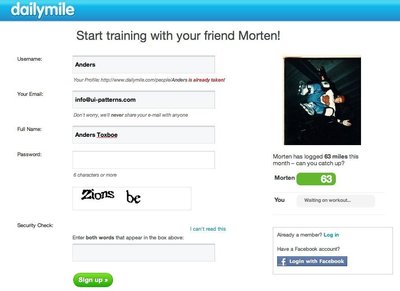Social Proof
Design Pattern
Alternate titles: Social Default Effect, Informational Social Influence, Herd Behavior.
Problem summary
We assume the actions of others in new or unfamiliar situations
Example
Usage
- Use to assure visitors of that your product is well respected and frequently used by their similar others.
- Use to establish trust
- Highlight certain behavior to direct users’ actions toward continuing that specific behavior.
- Use when you want to ease decisions for your users and assure them that they are not alone.
This card is part of the Persuasive Patterns printed card deck
The Persuasive Patterns Card Deck is a collection of 60 design patterns driven by psychology, presented in a manner easily referenced and used as a brainstorming tool.
Get your deck!Solution
Highlight the same social activity on your website that you want your users to conduct. Consider what kind of your behavior you want users to perform and find ways to show social proof of that exact behavior.
There are several ways to highlight what is the more correct behavior. Let us look at how we can appeal to users’ logic, emotions, and belief in your credibility.
6 ways to use Social Proof
You can play on social proof in a large variety of ways. Here’s just a few for inspiration.
- Expert social proof. Approval from a credible expert, like a magazine or blogger, can have incredible digital influence.
- Celebrity social proof. A strong identification with celebrities effectively drives decisions.
- Customer social proof. Simply displaying the logos of your most prominent and recognisable customers will let potential customers know that they are in good company.
- User social proof. Testimonials and proof of user action help guide users into making a decision.
- Wisdom of crowds. Highlighting popularity or large numbers of users implies “they can’t all be wrong.”
- Wisdom of friends. We prefer to say yes to the requests of someone we know and like.
Appeal to logic, emotions, and to ethical character
Appealing to facts and logic
Communicate social proof through facts, statistics, and logic. Common examples on community sites are “8 people liked this”, “434 viewed this image”, or “this blog post has 12 comments”. Subjectivity can also be communicated quantitatively: “4 out of 5 stars” or “92% liked this”.
Social proof helps us determine what is good behavior on a given website and is thus crucial for getting first-time users started. Last.fm uses leaderboards of their most played music by genre to guide visitors and getting them started with listening to great music.
Web applications often have pricing plans highlighting the company’s most wanted subscription plan with a “most popular plan” tag line in the hopes having users in doubt of which plan to choose select just that plan.
Appealing to emotions
Emotions have the power to modify our judgments, why appealing to emotions can help burst positive arguments or dampen negative arguments.
Cater to people’s emotions by listing testimonials of people who like your product. If you want to assure potential customers that your product is worth its price, then list testimonials from satisfied paying customers.
Appealing to ethics, moral, and character
Your audience will judge your propositions as being more true and acceptable if you succeed to establish your credibility.
- Use role models. Learn who your audience looks up to and compares itself to and seek out positive role models to guide their behavior. The authority of experts or influential people similarity of friends and audience can drive behavior. Testimonials, expert quotations, and statistics are efficient ways to communicate.
- Present social evidence next to Call to Actions. Provide mental shortcuts for users to decide through social evidence of the previous decisions of others. Use testimonials, expert quotations, and statistics to encourage desired behaviors.
- Similarities between group and self. People are more likely to conform to a group’s behavior if they perceive themselves belonging to the same or similar group. Communicate characteristics relevant to the user’s segment or context, such as related behavior, proximity, gender or age, interests, or profession to influence behavior.
Rationale
We have a common tendency to adopt the opinions and follow the behaviors of the majority to feel safer and to avoid conflict.
Social Proof establishes the norm others follow through experts, celebrities, the crowd, friends, or similar users. Communicate Social Proof testimonials, expert quotations, related actions by friends, or statistics like number of views, followers, or comments to encourage desired behaviors.
The actions of those around us are important when we decide what constitutes correct behavior. Whether it is to choose between two restaurants, to litter on the street, how fast to drive in a certain stretch on the highway, or which youtube video to watch first, we look to those around us to determine the correct answer.
Assuming that those around us are behaving normally, we will make fewer mistakes by acting in accord with social evidence than contrary to it. Acting in accord with social evidence is a shortcut to correct behavior and an often good decision.
Social proof is so effective as most of us would rather imitate that initiate. Independent thought requires expensive brain energy, why we often resort to short-cutting our thought processes where we can.
Your audience will judge your propositions as being more true and acceptable if you succeed to establish your credibility. Especially if your product is new, it’s critical to establish credibility with potential customers
Related studies
In 1951, Salomon Asch5 set up an experiment to prove social proof.
The setup: Entering a room together with a conferederate assumed to be other participants, 50 young adults were shown a depecting a target line next to three lines A, B, C and asked which was most similar in length to the target line. Although the answer was always obvious, the confederaates purposefully gave the wrong answer before the participant.
The result: Over 12 trials, participants conformed at least once 75% of the time.
Discussion
This pattern is closely related to the bystander-effect, herd-mentality, and the band-wagon effect.
Getting social proof right
Even though social proof is one of the most effective means of persuasion, you do need to keep a couple of things in mind for it to be effective.
- Negative social proof can backfire. The message “Many past visitors have removed the petrified wood from the park, destroying the natural state of the Petrified Forest.” lead to park visitors stealing more, not less.
- Social proof works better with pictures. Testimonials is one of the most effective ways to use social proof. Furthermore, displaying faces alongside them increased trust even more – even when the photos were “nonsensical.”
- We are influenced more by people similar to us. We’re more likely to be influenced by people we know or like. The closer you can hit to home, the more effective your efforts will be. Being from the same town connects more than being from the same country. Liking the same band connects more than liking the same style of music.
- Authority rules. We’re more likely to act on information, if it’s communicated by an expert – or at least a credible and authoritative source. Authority in itself influences behavior through credibility, and is as such an extension of social proof.\
Keeping a balance: social proof boosters and killers
Some situations strengthen the effect of social proof while others weaken it.
Modifiers strengthening the power of social proof
Identification of group with self
People are more likely to conform to a group’s behavior if they perceive themselves belonging to the same or similar group than of they do not identify with the group.
Modifiers weakening the power of social proof
Special knowledge
People are less likely to conform to a group’s behavior if they perceive themselves as better advised about a situation than the surrounding group.
Identification with authority
People are less likely to conform to a group’s behavior if they perceive themselves as a relevant authority figure in the situation. Perceived authority often happens when people have special training or knowledge that allows them to draw such conclusion.
1 Stephen Anderson (2009), “Get Mental Notes”, http://getmentalnotes.com
2 Cialdini, R. (1993), Influence: Science and practice (3rd edn), New York: HarperCollins
3 “Social Proof”, Wikipedia.org, http://en.wikipedia.org/wiki/Social_proof
4 “Social Proof”, The Decision Lab, https://thedecisionlab.com/reference-guide/psychology/social-proof/
5 Asch SE. Effects of group pressure upon the modification and distortion of judgments. In: Guetzkow H, ed., Groups, leadership and men; research in human relations. Pittsburgh PA: Carnegie Press; 1951.
6 Nonprobative photographs (or words) inflate truthiness by Newman EJ, Garry M, Bernstein DM, Kantner J, Lindsay DS.
7 Social Proof behavioral design pattern at Learning Loop
More examples of the Social Proof pattern See all 28 example screenshots








User Interface Design Patterns
- Forms
- Explaining the process
- Community driven
- Tabs
- Jumping in hierarchy
- Menus
- Content
- Gestures
- Tables
- Formatting data
- Images
- Search
- Reputation
- Social interactions
- Shopping
- Increasing frequency
- Guidance
- Registration
Persuasive Design Patterns
- Loss Aversion
- Other cognitive biases
- Scarcity
- Gameplay design
- Fundamentals of rewards
- Gameplay rewards







